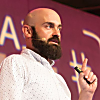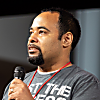Leading teams that stretch worldwide means managing team members from various cultural backgrounds.
Three years ago, I moved to Mexico City from New York to open a regional engineering office. While it was no easy task to build a new team in a foreign market, it was even more difficult to make sure that they were autonomous, aligned with the company mission, and had trust in our leadership.
The personal growth I had to go through to take this step into new terrain, lead effectively, and create space for a deeper connection with my team was layered. While there were many company avenues, initiatives, and policies that were able to support me in this journey, it was my focus on individual growth that allowed me to transition into this new role gracefully.
Check your mindset
When we onboard someone new, we think about integrating them into the company as quickly as possible. We would like them to align with the broader norms of their team, taking the current status quo as the desired end result.
When your team members are part of different cultures, you should align how the team operates to their cultural norms as opposed to yours. Shifting into this mentality as a leader takes a huge burden off of the team; instead of them having to bridge the gap between their culture and you (or the company), your leadership style adapts to them.
While working in Mexico, I was coaching a report to be more direct in meetings and feedback sessions, as I was used to this working style in the US. I soon realized that I hadn’t invested the time to understand the benefits of my report’s style in working with a predominantly Mexican team. In the end, we both learned more about adaptable communication while remaining authentic to ourselves; he saw that directness could result in more accurate project estimations, while I saw that I could be more welcoming with a warmer approach.
Be open to change
After getting into the right mindset, it’s important to consider that you may have to operate your team differently and in unfamiliar ways. If you’re someone with a “Type A” personality like me, you may be used to being fully involved in your team’s operations in very specific ways: this precedent may change.
When I started hiring in Mexico, I had one of the five interviews done completely in Spanish at the suggestion of a coworker. While the candidate would eventually perform most of their day-to-day work in English, we hoped that interviewing in their native language would give them a safer space to shine.
At the time, I had just started learning Spanish, which meant that I had to entrust my Spanish-speaking coworkers to conduct these interviews on my behalf and to translate their feedback. I had to let go of my usual way of running interview panels. This meant ensuring the hiring team was aligned on values so that they could evaluate candidates who might be a good fit for the team. It also required a great deal of my trust in others’ interpretations of the candidates. Ultimately, this process gave us a more comprehensive idea of who our prospects were, creating a better candidate experience and leadership opportunities for newly hired employees in Mexico.
Adapt your communication style
There are many tools and articles out there that can shed information on differences that manifest across cultures; this can be a good starting point to understand how you might need to adapt. Using the Hofstede Insights, it’s clear to see that the United States and Mexico show high disparity in power distance and uncertainty avoidance.
Mexico scores higher on power distance, which refers to how much deference is given to authority figures. While in the US, we might be used to outspokenly debating with our bosses, this hasn’t necessarily been the working culture in Mexico. I noticed this played out in meetings at times; I would share my opinion only to have the conversation die down in response, while previous colleagues had found holes in my plans, made alternate suggestions, or asked a lot of questions. Understanding this led me to ask other people’s opinions before giving my own opinion.
Mexico’s higher score in uncertainty avoidance reflects that introducing ambiguous problems might create tension or insecurity in a team. To ensure a strong culture of innovation, I needed to better explain that innovation inherently requires uncertainty and failure. This meant I had to become a better storyteller to explain why we were taking on ambiguous problems and how our failures resulted in learning curves. In that regard, we were able to reframe ambiguity and failure as stepping stones toward success.
Be vulnerable
Encourage team members to share the things that make them unique. Being vulnerable is probably the thing that helped me the most, not only because it built trust, but because it helped me realize that I wasn’t alone in the experiences I was having.
I opened up to my team about being a woman in tech, about growing up visiting the tiny villages of Lebanon where my family is from, about my mental health journey, and so much more. In being my authentic self, so many of my coworkers opened up to me about their experiences being Mexican at a large American company, which gave me more insights on how we could better collaborate.
As a leader, taking the steps to connect with your team will go a long way. My way of doing this was learning Spanish. The team had always accommodated me by speaking in English, and then – when I felt brave enough – I returned the favor by participating in Spanish. Speaking Spanish to a roomful of people hadn’t been in my plans, but it helped me gain empathy for non-native speakers.
Have fun
Regardless of how you got into this position, you’re working with people from different parts of the world – have fun with it! Be open, stay curious, and get excited about the people you will meet along the way. These lessons made me a stronger leader overall, and it’s a gift to have opportunities to work across cultures.








.jpg)








.png)


 - Emre Çağlar.jpg)



.png)
.png)





.jpg)







_0.png)












.jpg)

















_0.png)







































.png)

























.png)






.jpg)






 (1)_1.png)


.png)

.png)









.png)

.png)


.png)
























.png)









.png)
 (1).png)


 (1).png)


.png)
.png)


.png)






.png)
 (1).png)


.png)


.png)


 (2).png)
.png)
.jpg)

 2.png)




.png)
.png)





.png)



.png)
.png)

 (1).png)


.png)

.png)



 (1).png)


.png)

.png)
.png)



.png)
.png)
.png)

.png)


.png)

.png)


.png)




.png)
.png)
.png)




.png)
 (1).png)








 (1).png)

.png)










.png)
.png)






.png)





 (1).png)


.png)
.png)
.png)

 (1).png)

.jpg)
.png)
.jpg)

.jpg)

 (1).png)
.png)


.png)



























 (1).png)

.png)


 Brasseur.png)





















.png)

